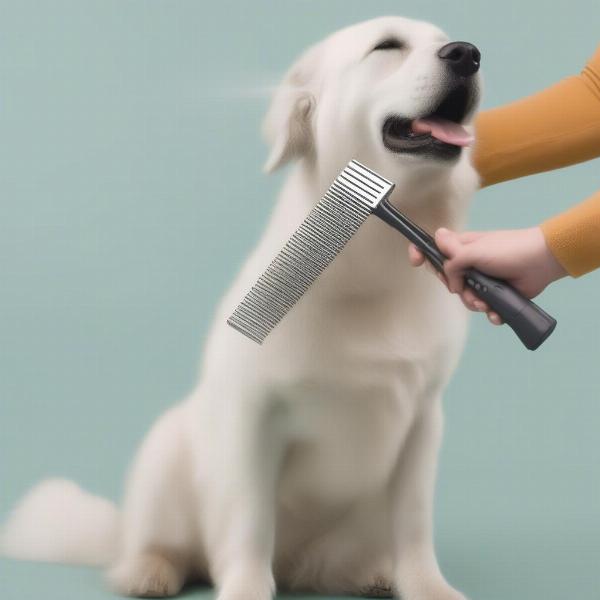The dog grooming rake tool is a must-have for any pet owner dealing with shedding. This specialized brush delves deep into your dog’s coat to remove loose undercoat and mats, promoting a healthier, more comfortable pet. Whether you’re a seasoned dog owner or just starting out, understanding how to use a dog grooming rake can significantly improve your grooming routine and your dog’s overall well-being.
Choosing the right rake, using it correctly, and understanding the benefits are key to making the most of this valuable tool. From reducing shedding around your home to preventing painful mats, the dog grooming rake offers numerous advantages for both you and your furry friend. We’ll cover all of this and more, helping you navigate the world of dog grooming rakes and find the perfect fit for your canine companion.
Choosing the Right Dog Grooming Rake Tool
Selecting the right dog grooming rake depends on your dog’s breed, coat type, and size. Rakes come with different numbers and lengths of teeth. For dogs with thick, double coats, a rake with longer teeth is ideal for reaching the undercoat. Shorter-toothed rakes are better for dogs with thinner coats or sensitive skin.
Considering Your Dog’s Coat
Is your dog a heavy shedder with a dense undercoat like a Husky or German Shepherd? Then a dog rake with longer, sturdier teeth is a must. For breeds with finer coats, like a Poodle, a rake with shorter, more closely spaced teeth will be gentler and more effective.
Different Types of Rakes
There are various types of dog grooming rakes available, from those with straight teeth for dematting to those with curved teeth for general shedding control. Understanding the different types will help you choose the best one for your dog’s needs. Some rakes also come with dual-sided heads, offering both dematting and deshedding options in one tool.
Using the Dog Grooming Rake Correctly
Using a dog grooming rake correctly is crucial for preventing discomfort and achieving the best results. Always brush in the direction of hair growth, starting from the head and working your way down to the tail. Be gentle, especially around sensitive areas like the belly and underarms.
Step-by-Step Guide
- Prepare your dog: Make sure your dog is comfortable and relaxed.
- Start brushing: Gently begin brushing in the direction of hair growth.
- Focus on problem areas: Pay extra attention to areas prone to matting, like behind the ears and under the legs.
- Take breaks: If your dog gets restless, take breaks and offer positive reinforcement.
Avoiding Common Mistakes
One common mistake is applying too much pressure, which can irritate your dog’s skin. Another mistake is using the rake on dry, tangled fur. Lightly misting your dog’s coat with a detangling spray can make the grooming process easier and more comfortable. For dogs with sensitive skin, a dog shedding brush might be a better choice.
 Using Dog Grooming Rake Correctly
Using Dog Grooming Rake Correctly
Benefits of Using a Dog Grooming Rake
The benefits of regular grooming with a rake extend beyond simply reducing shedding. It can improve your dog’s skin and coat health, prevent mats, and even strengthen your bond with your furry friend.
Healthier Skin and Coat
Regular use of a dog grooming rake stimulates the skin’s natural oils, promoting a healthy and shiny coat. Removing the dead undercoat also allows for better air circulation, which can help prevent skin infections. Specifically, for breeds like Labradoodles, a specialized dog brush for labradoodle can be extremely beneficial.
Preventing Mats and Tangles
Mats and tangles can be painful for dogs and can lead to skin irritation. A dog grooming rake can effectively remove existing mats and prevent new ones from forming.
Conclusion
The dog grooming rake tool is an invaluable asset for maintaining your dog’s health and hygiene. By choosing the right rake, using it correctly, and understanding its numerous benefits, you can significantly improve your dog’s grooming experience and overall well-being. Regular grooming sessions not only keep your home cleaner but also contribute to a stronger bond between you and your furry companion.
FAQ
- How often should I use a dog grooming rake? The frequency depends on your dog’s breed and coat type. For heavy shedders, weekly grooming is recommended.
- Can I use a dog grooming rake on all breeds? While generally safe for most breeds, it’s essential to choose the right type of rake for your dog’s coat.
- What should I do if my dog’s coat is heavily matted? Consult a professional groomer for severe matting, as attempting to remove them yourself can cause pain and discomfort.
- Is it normal for my dog to shed some hair even after using a rake? Some shedding is normal, even with regular grooming. The rake helps minimize excessive shedding.
- How do I clean my dog grooming rake? Most rakes can be cleaned with soap and water. Make sure to dry them thoroughly to prevent rust.
- Can I use a dog grooming rake on a puppy? Yes, but be extra gentle. A 4 paws dog grooming kit might be suitable for puppies.
- What’s the difference between a dog grooming rake and a regular brush? A rake is designed to penetrate the undercoat and remove loose hair, while a regular brush focuses on the topcoat.
ILM Dog is your trusted source for expert dog care advice and information. We offer a wealth of resources on dog breeds, health, training, nutrition, grooming, and much more. From choosing the right poop scooper for dogs to understanding complex grooming techniques, ILM Dog is dedicated to helping you provide the best possible care for your canine companion. Contact us today at [email protected] or +44 20-3965-8624 for personalized guidance.